ECOPLAN tools
The end products aim to fulfill specific needs in planning and implementing spatial planning processes. Most projects go through phases of societal analysis, vision building, design and planning before implementation finally takes place. For each phase, different information needs exist.
- First a principal decision is taken to re-organize an area in function of certain objectives (eg. Housing quality, regional development, ecological objectives, sustainable production, etc.). In most cases this sis followed by a (participative) vision building phase, where various actors are involved and surveyed for what they wish to achieve in an area. This is then translated into specific objectives for an area.
- In a second phase (design) is examined which land-use transitions (agricultural, residential, industrial, nature) are desirable, taking into account the existing spatial context, legislation and project objectives. Alternative development scenarios (with differences in ES-delievery) can be compared and evaluated.
- In a third phase, the project is implemented and decisions are made on specific land-cover, management and mitigation measures. This can also specifically address the management of particular zones (eg. The type of trees, installment of infiltration ponds, construction of buffer strips, botanical management, nature management, limitations on fertilizer application, etc.).
In all of these phases there are specific needs for information and support to planning for Ecosystem Services.
ECOPLAN tools in relation to planning processes

If we entail to include Ecosystem Services in planning, we need to build awareness on ecosystem services. It is essential that the general public and actors in planning and policy are aware that It is possible to design and manage landscapes in such a way that this increases the delivery of crucial ES. Integrating ES into vision building, planning and implementation at different scales will contribute to sustainable development of the Flemish Region providing leverage for cross-policy cooperation and increasing resilience against climate change. This contributes to a more efficient use of the limited financial resources for the environment, recreation, agriculture and biodiversity.
Therefore we need to provide information that is practical to support planning for ES. Information on the demand, actual and potential supply of ES can be used to build scenarios that spatially implmenent land, soil and water management measures in landscapes. Beside maps, we also need to provide information on the impact of certain land-use management changes. the impact of specific measures for a given context can be explored quiclkly by use of the ES-impact explorer (qualitative) and the ES-trade-off tool (quantitative).
Finally a full detail, high resolution, spatially distributed scenario analysis model will provide information on the impact of the scenario. Especially the many ES that are mediated through spatial processes such as groundwater flow, surface water flow, run-off may be too inaccurate for decision support on smaller spatial scales when we apply conceptual modeling tools. Actual physically distributed dynamic modelling for several ES may provide insight in these spatial relations between ES-generation and ES-benefits.